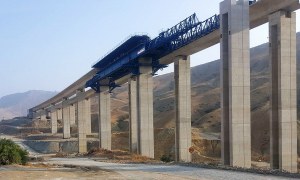🕑 Reading time: 1 minute
- The earliest suspension bridges were found in China, dating back to 206 B.C.
- Many of the earlier bridges were made from materials such as twisted grass.
- In the early 19th century, iron chains became a popular material for suspension bridges.
The Basic Components
- Two towers
- The catenary system
- A ground anchor
- A level truss stiffened deck
- A design to support heavy loads
- The towers are the struts for the suspension bridge. They receive all of the compressive forces.
- These members have to be thick enough resist buckling, flexure, and oscillation.
- They have to withstand minor changes as a result of live loads and temperature changes.
- The main job of the towers is to withstand the forces that are exerted on it by the cables.
- The anchorages pull the side spans to the ground and fixes them in place.
- The anchors must be able to hold down the cable with its weight or by transferring the tension in the ropes to the ground.
The Cables
- All of the tension forces in the bridge is transferred to the main cable through the suspenders.
- The cables have to support the deck and live loads without having to overstress any member.
- The cables need to allow vibration and be resistant to corrosion.
The Deck
- The deck needs to be ridge to prevent any dipping as live loads pass, yet it needs to be as light as possible.
- The deck is a major factor in calculating the dead load and tension in the main cable.
Structural Principles
- A main cable of a suspension bridge resembles a parabola. The hangers, or suspenders, are placed at equal intervals from each other.
- To calculate the height of each hanger, we can measure the two end heights, the center height, and get an equation for a parabola.
- The moment of the weight of the anchor must be greater than that coming from the tension in the cable.
- In other words, you want your anchor to be heavy enough to hold down the cables, regardless of what type of anchor you decided to use.
The Forces
- The forces on the cables of a suspension bridge are all tension. The horizontal forces for each member are equal, and the vertical forces increase in the direction of the towers.
Finding Force
Calculating the force is a result of the length of the bridge and the weight of the deck. The tension at each end of the bridge carries half the weight of the bridge.
The tension in the main cable is also a result of the height of the tower. (The higher you tower, the less tension at the top,but there will be a greater chance of buckling.)
Cable Materials
- For a small projects, single rope or single strand wires can be used.
Implementation
- Where the towers are founded on underwater piers, caissons are sunk and any soft bottom is excavated for a foundation. If bedrock cannot be reached, pilings are driven to bedrock or hard soil, or a large concrete pad may be constructed. The foundation piers are then extended to above water level.
- Where the towers are founded on dry land, deep foundations or pilings are used.
- From the tower foundation, towers of multiple columns are erected using concrete, stonework, or steel structures. At some elevation there must be a passage for the deck, with the columns extending high above this level.
- Smooth open cable paths called saddles are anchored atop the towers. These allow for slight movements of the cable as the loads change during construction. The top of these saddles may be closed with an additional part after completion of the bridge.
- Anchorages are constructed to resist the tension of the cables. These will have multiple protruding open eyebolts.
- A temporary suspended walkway supported by wire rope follows the curve of the cables to be constructed, mathematically described as a catenary arc.
- Another set of wire ropes are suspended above the walkway and are used to support a traveler that has wheels riding atop these cables. There will be one set of wire ropes and a traveler for each cable to be "spun"
- Pulling cables attached to winches are capable of pulling the traveler from one anchorage to the other, traveling in arcs to the tops of the two towers.
Advantages
- Low cost
- All tension forces are in cables/ All compression forces are in towers
Disadvantages
- Balancing the tensions during and after construction
- Rigidity
- Construction of cables


